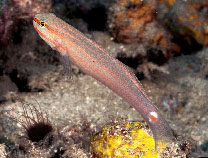| Family: |
Gobiidae (Gobies), subfamily: Gobiinae |
| Max. size: |
9.5 cm SL (male/unsexed) |
| Environment: |
reef-associated; brackish; marine; depth range 3 - 25 m |
| Distribution: |
Western Central Pacific: Philippines to New Caledonia, north to Yaeyama Islands, south to the Great Barrier Reef; throughout Micronesia. |
| Diagnosis: |
Dorsal spines (total): 7-7; Dorsal soft rays (total): 14-14; Anal spines: 1-1; Anal soft rays: 14-14. Characterized by pale bluish-grey body color with pair of distinct orange stripes on head; sides with four faint orange stripes and diffuse cross-bars; base of caudal fin with orange spot;; first and second dorsal fin equal in height; rounded caudal fin; longitudinal scale series 55-60; predorsal scales 23-28; scales dorsally on opercle, absent on cheek; ctenoid body scales; cycloid scales on nape, abdomen, and opercle; depth of body 4.0-4.6 in SL (Ref. 90102). |
| Biology: |
Inhabits muddy bottoms of inshore bays and lagoons from about 3 to at least 20 m and uses a vertical, tube-like burrow of an unidentified invertebrate for refuge (Ref. 1602). Occurs in coastal and inner reefs on sand and rubble flats to about 20 meters depth (Ref. 48637). Feeds by sifting mouthfuls of sand to capture small invertebrates and organic matter (Ref. 1602). |
| IUCN Red List Status: |
Least Concern (LC); Date assessed: 26 August 2020 Ref. (130435)
|
| Threat to humans: |
harmless |
Source and more info: www.fishbase.org. For personal, classroom, and other internal use only. Not for publication.

